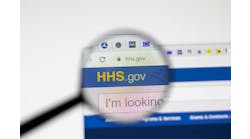Nearly two dozen healthcare organizations sent a letter to members of a U.S. House of Representatives committee asking them to remove language that prevents the U.S. Department of Health and Human Services (HHS) from engaging with the private sector to work on improved patient identification tools.
The letter, which was sent to Representative Hal Rogers, chairman of the House Committee on Appropriations and Rep. Tom Cole, chairman of the Subcommittee on Labor. Health and Human Services, Education and Related Agencies as well as ranking members, was signed by officials from the American Health Information Management Association (AHIMA), American Medical Informatics Association (AMIA), College of Health Information Management Executives (CHIME), the EHR Association, the Healthcare Information and Management Systems Society (HIMSS) and Health IT Now. Additionally, healthcare providers such as Intermountain Healthcare and Nemours Children’s Health System as well as organizations such as Premier Healthcare Alliance and The Sequoia Project also signed the letter.
Essentially, the organizations applauded House legislative report language that could remove barriers to HHS engaging with the private sector to develop patient identification solutions to accurately match patients to the correct medical record.
“The patient matching report language enables the U.S. Department of Health and Human Services (HHS), acting through the Office of the National Coordinator for Health Information Technology (ONC) and the Centers for Medicare & Medicaid Services (CMS), to provide technical assistance to private-sector led initiatives aimed at developing a coordinated national strategy that will promote patient safety by accurately identifying patients and matching them to their health information,” the letter stated. “Allowing ONC and CMS to offer this type of technical assistance will help accelerate and scale safe and effective patient identification and matching solutions.”
Since 1999, Congressional language has prohibited HHS from using its funds to work on a patient matching solution due to privacy concerns over the potential misuse of a unique patient identifier.
The healthcare organizations contend that inaccurate patient identification and errors in patient matching can lead to serious medical mistakes and are major barriers to improving the quality and efficiency of care across the continuum. “House appropriators highlighted this challenge in report language accompanying the Fiscal 2017 Labor-HHS Appropriations Bill, labelling the ‘lack of a consistent patient data matching strategy’ as one of the ‘most significant challenges’ to safe and secure electronic health information exchange,” according to the letter.
Although the appropriations bill retains the ban on finalizing a rule around patient identification, clarifying HHS’s latitude to work with the private sector on a solution to patient matching would mark a significant step forward, the organizations stated. The letter urges House and Senate Appropriators to ensure the report language accompanies future Labor-HHS Appropriations Bills.
In the letter, healthcare organizations wrote,” The absence of a national strategy for accurately identifying patients has resulted in significant costs to hospitals, health systems, physician practices, and long-term post-acute care (LTPAC) facilities as well as hindered efforts to facilitate as well as hindered efforts to facilitate health information exchange. More importantly, there are patient safety implications when data is lacking from a patient’s record due to identity issues.”
“We’ve made great progress in digitizing the nation’s healthcare system,” CHIME president and CEO Russell Branzell said in a prepared statement. “But if we are going to improve patient safety and care from one provider setting to another, we must be able to ensure with 100 percent accuracy that we properly identify patients and match them to their records and not a different John Doe. The report language is a recognition that patients deserve to know that the information in their electronic health record (EHR) belongs to them and that it contains all relevant information necessary for informed clinical decision making.”
Lynne Thomas Gordon, CEO of AHIMA, said in a statement, “Accurately matching health information to the correct patient is crucial to reducing potential patient safety risks and improving nationwide health information exchange. Allowing public-private collaboration will encourage an open discussion and help foster a solution that is cost-effective and scalable while ensuring that appropriate privacy controls are in place to protect patient privacy.”

